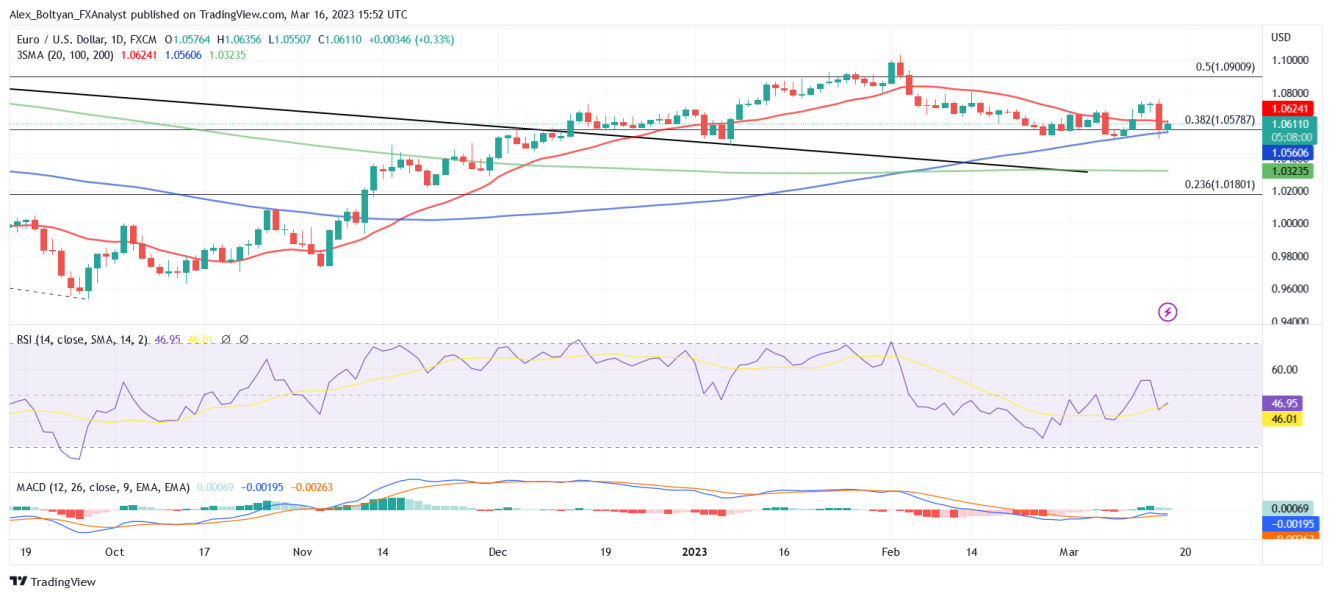The EUR/USD pair is oscillating around 1.0600 on Thursday following the European Central Bank's (ECB) decision to raise rates by 50 basis points as expected, recovering some of Credit Suisse's driven losses the previous day.
At the time of writing, the EUR/USD pair is trading at 1.0605, 0.23% above its opening price, after hitting a daily high of 1.0635 earlier on the day. The euro has recovered nearly a hundred pips after bottoming at a two-month low of 1.0516 on Wednesday.
As widely anticipated, the ECB increased three main rates by 50 bps on Thursday, sending the deposit facility rate to 3%. The lack of forward guidance was the only notable change as the ECB highlighted the importance of the data-dependent approach, which "will be determined by the inflation outlook in light of economic and financial data."
In a presser following the announcement, ECB President Christine Lagarde stated, "It's impossible to determine what the rate path will be" relating to the banking situation and the economic slowdown in the EU. However, she also said that the banking sector is currently in a much stronger position than in 2008 and that the ECB can exercise creativity in short order if there is a liquidity crisis. "We are monitoring current market tensions closely and stand ready to respond as necessary to preserve price stability and financial stability in the euro area," reads the statement.
Meanwhile, U.S. and European yields edged lower, signaling investors seeking refuge in government bonds amid worries regarding the banking sector on both shores of the Atlantic. The U.S. 10-year Treasury yield stands at 3.44%, while the German 10-year Bund yield sits at 2.21%.
Data in the U.S. showed unemployment claims dropped to 192,000 in the week ending March 10, while the housing sector reported a 13.8% increase in building permits in February. Investors' attention now turns to the Fed decision next week, pricing a 25 bps hike as the most likely outcome.
From a technical perspective, the EUR/USD short-term outlook has turned neutral to slightly bearish, according to indicators on the daily chart. However, the pair still holds above the 100-day Simple Moving Average (SMA), acting as dynamic support at the 1.0560 area.
A break below the 100-day SMA will pave the way to a retest of the 1.0500 psychological level and the 2023 low of 1.0483. On the flip side, resistance levels could be found at the 20-day SMA at 1.0623 and 1.0700, ahead of weekly highs at the 1.0760 region.
- English (UK)
- English (India)
- English (Canada)
- English (Australia)
- English (South Africa)
- English (Philippines)
- English (Nigeria)
- Deutsch
- Español (España)
- Español (México)
- Français
- Italiano
- Nederlands
- Português (Portugal)
- Polski
- Português (Brasil)
- Русский
- Türkçe
- العربية
- Ελληνικά
- Svenska
- Suomi
- עברית
- 日本語
- 한국어
- 简体中文
- 繁體中文
- Bahasa Indonesia
- Bahasa Melayu
- ไทย
- Tiếng Việt
- हिंदी
EUR/USD Holds on to 1.0600 After ECB Despite Banking Turmoil
Published 03/16/2023, 12:18 PM
Updated 07/09/2023, 06:32 AM
EUR/USD Holds on to 1.0600 After ECB Despite Banking Turmoil
Latest comments
Loading next article…
Install Our App
Risk Disclosure: Trading in financial instruments and/or cryptocurrencies involves high risks including the risk of losing some, or all, of your investment amount, and may not be suitable for all investors. Prices of cryptocurrencies are extremely volatile and may be affected by external factors such as financial, regulatory or political events. Trading on margin increases the financial risks.
Before deciding to trade in financial instrument or cryptocurrencies you should be fully informed of the risks and costs associated with trading the financial markets, carefully consider your investment objectives, level of experience, and risk appetite, and seek professional advice where needed.
Fusion Media would like to remind you that the data contained in this website is not necessarily real-time nor accurate. The data and prices on the website are not necessarily provided by any market or exchange, but may be provided by market makers, and so prices may not be accurate and may differ from the actual price at any given market, meaning prices are indicative and not appropriate for trading purposes. Fusion Media and any provider of the data contained in this website will not accept liability for any loss or damage as a result of your trading, or your reliance on the information contained within this website.
It is prohibited to use, store, reproduce, display, modify, transmit or distribute the data contained in this website without the explicit prior written permission of Fusion Media and/or the data provider. All intellectual property rights are reserved by the providers and/or the exchange providing the data contained in this website.
Fusion Media may be compensated by the advertisers that appear on the website, based on your interaction with the advertisements or advertisers.
Before deciding to trade in financial instrument or cryptocurrencies you should be fully informed of the risks and costs associated with trading the financial markets, carefully consider your investment objectives, level of experience, and risk appetite, and seek professional advice where needed.
Fusion Media would like to remind you that the data contained in this website is not necessarily real-time nor accurate. The data and prices on the website are not necessarily provided by any market or exchange, but may be provided by market makers, and so prices may not be accurate and may differ from the actual price at any given market, meaning prices are indicative and not appropriate for trading purposes. Fusion Media and any provider of the data contained in this website will not accept liability for any loss or damage as a result of your trading, or your reliance on the information contained within this website.
It is prohibited to use, store, reproduce, display, modify, transmit or distribute the data contained in this website without the explicit prior written permission of Fusion Media and/or the data provider. All intellectual property rights are reserved by the providers and/or the exchange providing the data contained in this website.
Fusion Media may be compensated by the advertisers that appear on the website, based on your interaction with the advertisements or advertisers.
© 2007-2025 - Fusion Media Limited. All Rights Reserved.
